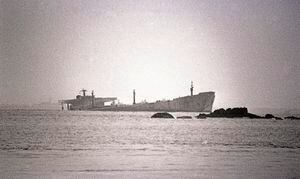Fund set up in wake of oil spill seeks projects
FOUR decades after a devastating oil spill off the Brittany coast threatened to pollute Channel Island beaches, a special fund established in its wake is looking for more projects to support.

The Jersey Ecology Trust was set up in 1991 with £344,592, Jersey’s share of $155m. damages imposed by an American court on the Amoco Corporation, owner of the Amoco Cadiz oil tanker.
The vessel ran aground off the coast of Brittany on 16 March 1978 in extreme storm conditions. Over the following two weeks, the 223,000 tonnes of oil and 4,000 tonnes of ship’s fuel spewed into the sea, posing a serious threat to the Channel Islands.
Thankfully, favourable tidal and wind conditions and rough seas – and the efforts of the Royal Navy, UK and local fishermen to disperse the 40-mile long slick – kept it at bay.
Deputy Scott Wickenden, chairman of the Ecology Fund, said: ‘The Amoco Cadiz spill had a devastating impact on wildlife and marine habitats across the Channel. However, through the insight and hard work of islanders who helped establish the Ecology Fund, some good has come out of it.
‘The projects it has helped fund over the years have addressed some of the ongoing environmental issues Jersey faces, such as declining habitat, impact of development and commercial exploitation, and inspired and educated a new generation.’
More than £150,000 has been paid out since 1991 to almost 150 local projects. These have included a nature garden at Mont a l’Abbe School, a Birds on the Edge project to revive declining farmland bird numbers, a study of the local red squirrel population and woodland management training for Jersey Trees for Life.
Mont a l’Abbe School head teacher Liz Searle said: ‘We are grateful to the Ecology Fund for giving us a donation of £1,300 last year to enable us to carry out maintenance in the forest school area so the children could continue to use this wonderful learning space.’
The threat to the islands from the Amoco Cadiz disaster was over by the end of March 1978. The islands escaped relatively unscathed, but dead birds and tar continued to be washed up on Jersey and Guernsey beaches for many months.
However, it took many years for the Brittany coast to recover. By the end of April 1978, the slick had contaminated almost 200 miles of it, clogging holiday beaches with a thick black layer of crude oil, contaminating shellfish stocks and killing at least 20,000 sea birds and millions of molluscs, sea urchins and clams. The clean-up operation involved 6,000 French soldiers and thousands of volunteers. Some beaches had to be cleaned six times and traces of the pollution can be seen to this day.





